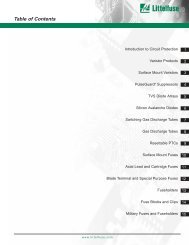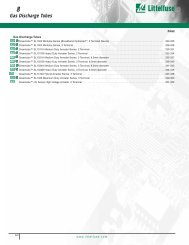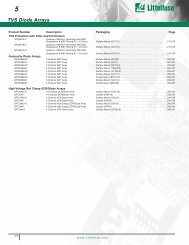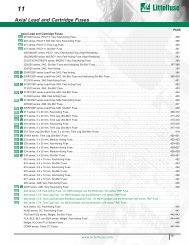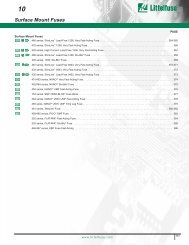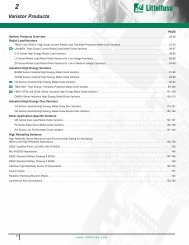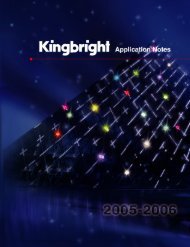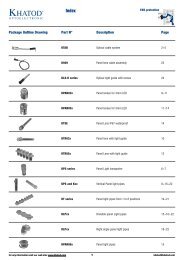ALUMINUM ELECTROLYTIC CAPACITORS
ALUMINUM ELECTROLYTIC CAPACITORS
ALUMINUM ELECTROLYTIC CAPACITORS
Create successful ePaper yourself
Turn your PDF publications into a flip-book with our unique Google optimized e-Paper software.
DT=DT0·(Ix/Io) 2<br />
PRECAUTIONS AND GUIDELINES<br />
Where : DT0=5 deg for 105C maximum rated capacitors.<br />
Io =Rated ripple current (ARMS) : if its frequency is different<br />
from operating ripple current Ix, it needs converting<br />
by using a frequency multiplier<br />
prescribed in the catalog.<br />
lx =Operating ripple current (ARMS) actually flowing into a<br />
capacitor<br />
Like switching power supplies, if the operating ripple current<br />
con sists of commercial frequency element and switching frequen<br />
cy element(s), an internal power loss is expressed by<br />
the following equa tion.<br />
W= (If1) 2 ·ESRf1+ (If2) 2 ·ESRf2+···+ (Ifn) 2 ·ESRfn<br />
Where : W =Internal power loss<br />
If1···If1 =Ripple currents at every frequencies f1···fn<br />
ESRf1···ESRfn=ESR's at every frequenciesf 1···fn<br />
The above equation can be transformed into another equation<br />
to get a ripple current value in accordance with the frequen<br />
cy of the rated ripple current, each of ESRf1,···ESRfn is<br />
ap prox i mate ly equal to ESRf0 di vid ed by square value of the<br />
frequency mul ti pli er (Ff1···Ffn). Here ESR f0 is the value at the<br />
fre quen cy of the rated ripple current and Ff1···Ffn is a con ver -<br />
sion co ef fi cient from one fre quen cy to another in accordance<br />
with the fre quen cy f1···fn.<br />
ESRf1=ESRf0 / (Ff1) 2<br />
···<br />
···<br />
ESRfn=ESRf0 / (Ffn) 2<br />
Relationship of w=(LRipple) 2 ·RESR leads lx as follows:<br />
Ix= W/ESRf0<br />
The above is rewritten in the following equation:<br />
Ix= (If1/Ff1)<br />
Where :<br />
2 +(If2/Ff2) 2 +······(Ifn/Ffn) 2<br />
Ix =Ripple current in accordance with the frequency of<br />
the rated ripple current<br />
If1······Ifn =Operating ripple currents at every frequencyf1···fn<br />
Ff1······Ffn=Frequency multipliers for every frequencyf1···fn<br />
prescribed in the catalog, based on the fact that<br />
the internal resistance of a capacitor varies with<br />
frequency.<br />
Cleaning Agents<br />
a. Cleaning agents penetrate into a capacitor.<br />
Solvent contacts the rubber seal of a capacitor. Some percent<br />
age of solvent does not penetrate but a per cent age<br />
suceeds in entering and defusing inside the ca pac i tor.<br />
b. Cleaning agents decompose and release halogen ions.<br />
In the electrolyte of the inside element, the halides in the<br />
cleaning agents become hydrolyzed and release halogen<br />
ions as follows,<br />
RX : Halide<br />
X - RX+H2O ROH+H<br />
: Halogen ion<br />
+ +X -<br />
(9/10)<br />
c. Corrosion<br />
The halogen ions attack the aluminum foil by the following<br />
anodic half-cell reaction:<br />
AI+3X - AIX3+3e<br />
The AlX3 further becomes hydrolyzed and release the halogen<br />
ion again:<br />
AIX3+3H2O AI (OH) 3 +3H + +3X -<br />
The halogen ions release by this hydrolysis reaction further<br />
attacks the aluminum according to the previous reaction formu<br />
la, and these reactions are repeated and accelerated when<br />
voltage and temperature is applied. Also, the hydrogen ions<br />
in crease the local acid i ty which causes the oxide dielectric to<br />
dissolve. Thus, localized corrosion accelerates to corrode both<br />
the alu mi num metal and the dielectric. In addition, a ter pene<br />
or petroleum system cleaning sol vent will be absorbed into<br />
the rubber seal of the capacitor. The rubber seal fi nally weakens.<br />
An alkaline saponifi cation detergent will damage the alumi<br />
num metal and marking. In summary, rec om mend ed cleaning<br />
agents are halogen free. Terpene, petroleum, alkali de ter -<br />
gent and any solvent making the rubber seal material de te -<br />
ri o rate are not recommended.<br />
Compatible cleaning agents:<br />
In line with recent global environmental warnings (Green house<br />
ef fect and other environmental destruction by depletion of the<br />
ozone layer), new types of cleaning agents have been commer<br />
cial ized and sub sti tut ed as CFC-113,1,1,2-trichloroethlene<br />
and 1,1,1-trichlo ro et h yl ene. The following are recommended<br />
cleaning conditions for some of new cleaning agents.<br />
Higher alcohol system cleaning agents<br />
Recommended cleaning agents:<br />
Pine Alpha ST-100S (Arakawa Chemical)<br />
Clean Through 750H, 750K, 750L, and 710M (Kao)<br />
Technocare FRW-14 through 17 (GE Toshiba Silicones)<br />
Cleaning conditions:<br />
1) Capacitors are capable of withstanding immersion or<br />
ul tra son ic cleaning for 10 minutes at a maximum liquid<br />
tem per a ture of 60C using the above cleaning agents.<br />
Find the optimum conditions for wash ing, rinsing, and<br />
dry ing. Be sure not to rub the marking off the ca pac i tor<br />
by contact with any other com po nents on the PC board.<br />
Note that shower cleaning adversely af fects the marking.<br />
2) To rinse by water, control the conditions such as temper<br />
a ture and wa ter pressure to avoid sleeve shrinking or<br />
swelling.<br />
3) Clean Through 750H and similar are weak-alkaline solvents.<br />
Do not leave the alkaline on the capacitor after<br />
clean ing process.<br />
CFCs substitute solvents (HCFC system)<br />
Asahi Glass AK225AES solvent is usable only with solvent<br />
resistant type capacitors, which are designed with reinforced<br />
seal constructions and modifi ed electrolyte. This product does<br />
not penetrate the ca pac i tor and deactivate halogen ions.<br />
How ev er, AK225AES is one of the sol vents which will have a<br />
re strict ed us age in future from the en vi ron men tal point of view.<br />
CAT. No. E1001H




